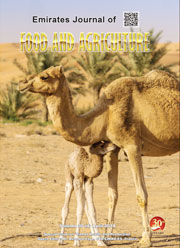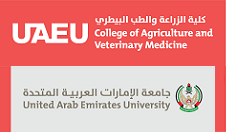Effect of the dehydration method of Hibiscus sabdariffa L. calyces on the quality of their aqueous extracts
DOI:
https://doi.org/10.9755/ejfa.2021.v33.i2.2181Keywords:
Hibiscus sabdariffa, anthocyanins, acidity, color, total soluble phenols.Abstract
Hibiscus sabdariffa L. is a plant from tropical climates, which produces, among other products, deep red calyces used to prepare refreshing drinks. The high humidity (85-87%) of the calyces at the time of harvest must be reduced to about 12% for handling and storage. The aim of the work was to evaluate the effect of the dehydration method of the calyces (sun drying, SD; air-drying, AD, at three temperatures: 50, 60 and 70 ºC) of three varieties of Hibiscus sabdariffa L. on the quality of their aqueous extracts. The quality was measured as a function of color), and chemical variables (titratable acidity, TA, total soluble phenols, TSP; total anthocyanins content TAC, and organic acids). The varieties used were Negra Quiviquinta (NQ) with dark red calyces, UAN-9 with light red calyces, and UAN-16, with white calyces. The dehydration method affected the quality of the extracts. The SD was the one that most affected the color and chemical variables. The color of the extracts was darker than that of the control while titratable acidity (TA) was reduced on average 40.6%. No effect of AD treatments was observed on these variables. On chemical composition, SD reduced TSP on average 15.3%, the most affected variety was UAN-16. In the varieties with red calyces, the average TAC reduction was 36.9%. Of the organic acids, the most affected were malic and succinic. As observed in physical variables, AD treatments showed little influence on chemical composition of calyces. Of the dehydration methods evaluated, the AD70°C rendered the best quality aqueous extract, in base of the variables evaluated.
Downloads
References
AOAC. Association of Official Analytical Chemists 1998. 16ª ed. St. Paul Minnesota, USA.
Ardestani S. B., M. A. Sahari and M. Barzegar. 2015. Effect of extraction and processing conditions on organic acids of barberry fruits. J. Food Biochem. 39: 554-565.
Bechoff, A., M. Cissé, G. Fliedel, A. L. Declemy, N. Ayessou, N. Akissoe, C. Touré, B. Bennett, M. Pintado, D. Pallet and K. I. Tomlins. 2014. Relationships between anthocyanins and other compounds and sensory acceptability of Hibiscus drinks. Food Chem. 148: 112-119.
Borrás-Linares, I., S. Fernández Arroyo, D. Arráez-Román, P. A. Palmeros-Suárez, R. Del Val Díaz, I. Andrade-Gonzáles, A. Fernández-Gutiérrez, J. F. Gómez-Leyva and A. Segura Carretero. 2015. Characterization of phenolic compounds, anthocyanidin, antioxidant and antimicrobial activity of 25 varieties of Mexican Roselle (Hibiscus sabdariffa). Ind. Crops. Prod. 69: 385-394.
Castañeda-Ovando, A., M. L. Pacheco-Hernández, M. E. Páez-Hernández, J. A. Rodríguez and C. A. Galán-Vidal. 2009. Chemical studies of anthocyanins: A review. Food Chem. 113: 859-871.
Cen, H., Y. Bao, Y. He and D. W. Sun. 2007. Visible and near infrared spectroscopy detection of citric and tartaric acids in orange juice. J. Food Eng. 82: 253-260.
Červenka, L., Z. Červenková and H. Velichová. 2018. Is air-drying of plant-based food at low temperature really favorable? A meta-analytical approach to ascorbic acid, total phenolic and total flavonoid contents. Food Rev. Int. 34: 434-446.
Cid-Ortega, S. and J. A. Guerrero-Beltrán. 2015. Roselle calyces (Hibiscus sabdariffa), an alternative to the food and beverages industries: a review. J. Food Sci. Technol. 52: 6859-6869.
Contreras, G. J. A., Soto, R. J. M. and Huchin, C. A. (2009). Tecnología para el cultivo de jamaica en Quintana Roo. Folleto Técnico No. 3. Chetumal, Quintana Roo. INIFAP-SADER. 40p. Retrieved on december 06, 2020 from: http://biblioteca.inifap.gob.mx:8080/jspui/bitstream/handle/123456789/3150/Jamaicaconforros.pdf?sequence=1.
Da-Costa-Rocha, I., B. Bonnlaerder, H. Sievers, I. Pischel and M. Heinrich. 2014. Hibiscus sabdariffa L.: A phytochemical and pharmacological review. Food Chem. 165: 424-443.
Farag, M. A., D. M. Rasheed and I. M. Kamal. 2015. Volatiles and primary metabolites profiling in two Hibiscus sabdariffa (roselle) cultivars via headspace SPME-GC–MS and chemometrics. Food Res. Int. 78: 327-335.
Fossen, T., R. Slimestad and Ø. M. Andersen. 2001. Anthocyanins from maize (Zea mays) and reed canarygrass (Phalaris arundinacea). J. Agric. Food Chem. 49: 2318-2321.
Galicia-Flores, L. A., Y. Salinas-Moreno, B. M. Espinoza-García and C. Sánchez-Feria. 2008. Caracterización fisicoquímica y actividad antioxidante de extractos de jamaica (Hibiscus sabdariffa L.) nacional e importada. Rev. Chapingo Ser. Hortic. 14: 121-9.
Ibrahim, S. K., B. A. Hasan and K. D. Khalaf. 2015. Separation and determination of some organic acids in dry calyces of Iraqui Hibiscus sabdariffa Linn. Baghdad Sci. J. 12: 340-349.
Ifie, I., L. Marshall, P. Ho and G. Williamson. 2016. Hibiscus sabdariffa (Roselle) extracts and wine: Phytochemicals profile, physicochemical properties, and carbohydrase inhibition. J. Agric. Food Chem. 64: 4921-4931.
Juliani, H. R., C. R. Welch, Q. Wu, B. Diouf, D. Malainy and J. E. Simon. 2009. Chemistry and quality of Hibiscus (Hibiscus sabdariffa) for developing of natural-product industry in Senegal. J. Food Sci. 74: 113-121.
Kunz, T., A. Strähmel, N. Cortés, L. W. Kroh and F. J. Methner. 2013. Influence of intermediate Maillard reaction products with enediol structure on the oxidative stability of beverages. J. Am. Soc. Brew. Chem. 71: 114-123.
Leggett, G. L. (2008). Color measurement techniques for food products. In Color quality of fresh and processed foods, edited by C. A. Culver and R. E. Wrolstad, 7-16. Washington, DC: American Chemical Society.
Meza-Jiménez, J., J. J. Ramírez-Ruiz, G. Luna-Solano and I. Andrade-González. 2009. Low-cost solar themodynamic drying system for the dehydration of roselle (Hibiscus sabdariffa L.). Dry. Technol. 27: 621-4.
Mohamed, B. B., Sulaiman A. A. and A. D. Abdelhafiz. 2012. Roselle (Hibiscus sabdariffa L.) in Sudan, cultivation and their uses. Bulletin of Environment, Pharmacology and Life Sciences. 1: 48-54.
NMX-FF-115-SCFI-2010. “Norma Mexicana. Productos agrícolas destinados para consumo humano – flor (cáliz) de jamaica (Hibiscus sabdariffa L.) – especificaciones y métodos de prueba”. 21 pp. Secretaría de Economía. Retrieved on november, 2020 from: http://www.economia-nmx.gob.mx/normas/ nmx/2010/nmx-ff-115-scfi-2010.pdf.
Obón, J. M., M. R. Castellar, M. Alacid and J. A. Fernández-López. 2009. Production of a red-purple food colorant from Opuntia stricta fruits by spray drying and its application in food model systems. J. Food Eng. 90: 471-479.
Patras, A., N. P. Brunton, C. O’Donnell and B. K. Tiwari. 2010. Effect of thermal processing on anthocyanin stability in foods; mechanisms and kinetics of degradation. Trends Food Sci. Technol. 21: 3-11.
Reyes-Luengas, A., Y. Salinas-Moreno, M. E. Ovando-Cruz, R. I. Arteaga-Garibay and M. D. Martínez-Peña. 2015. Analysis of phenolic acids and antioxidant activity of aqueous extracts of jamaica (Hibiscus sabdariffa L.) varieties with calyxes of different colors. Agrociencia. 49: 277-290.
Sadilova, E., R. Carle and F. C. Stintzing. 2007. Thermal degradation of anthocyanins and its impact on color and in vitro antioxidant capacity. Mol. Nutr. Food Res. 51: 1461-1471.
Saeed, I. E. 2010. Solar drying of roselle (Hibiscus sabdariffa L.): Mathematical modelling, drying experiments, and effects of the drying conditions. Agricultural Engineering International: CIGR Journal. 12: 115-123.
Salinas-Moreno, Y., A. R. E. Zuñiga-Hernández, L. B. Jiménez-De la Torre, V. Serrano-Altamirano and C. Sánchez-Feria. 2012. Color en cálices de jamaica (Hibiscus sabdariffa L.) y su relación con características fisicoquímicas de sus extractos acuosos. Rev. Chapingo Ser. Hortic. 18: 395-407.
Sánchez-Feria, C., Y. Salinas-Moreno, V. A. González-Hernández, M. C. Ybarra-Moncada, N. Cruz-Huerta and M. R. Soto-Hernández. 2018. Genotipo y ambiente de producción afectan la composición fenólica, ácidos carboxílicos y acidez titulable de cálices de Hibiscus sabdariffa L. Rev. Fitotec. Mex. 41: 373-383.
Sharma, G. (2003). Color fundamentals for digital imaging. In: Sharma G, editor. Digital color imaging handbook. Boca Raton, FL, United State.: CRC Press.
Singleton, V. L. and J. A. Rossi. 1965. Colorimetric of total phenolics with phosphomolybdic-phosphotungstic acid reagents. Am. J. Enol. Vitic. 16: 144-158.
Tsai, P. J., J. Mcintosh, P. Pearce, B. Camden and B. R. Jordan. 2002. Anthocyanin and antioxidant capacity in roselle (Hibiscus sabdariffa L.) extract. Food Res. Int. 35: 351-356.
Wahabi, H. A., L. A. Alansary, A. H. Al-Sabban and P. Glasziuo. 2010. The effectiveness of Hibiscus sabdariffa in the treatment of hypertension: A systematic review. Phytomedicine. 17: 83-86.
Weaver, C. M., B. R. Martin, J. S. Ebner and C. A. Krueger. 1987. Oxalic acid decreases calcium absorption in rats. J. Nutr. 117: 1903-1906.
Wilson, F. D. (1994). The genome biogeography of Hibiscus L. section Furcaria DC. Genet. Resour. Crop Evol. 41: 13-25.
Wojdyło, A., A. Figiel and J. Oszmianski. 2009. Effect of drying methods with application of vacuum microwaves on the bioactive compounds, color, and antioxidant activity of strawberry fruits. J. Agric. Food Chem. 57: 1337-1343.
Wong, P. K., S. Yusof, H. M. Ghazali and M. Y. C. Man. 2002. Physico-chemical characteristics of roselle (Hibiscus sabdariffa L.). Nutr. Food Sci. 32: 68-73.










 .
. 